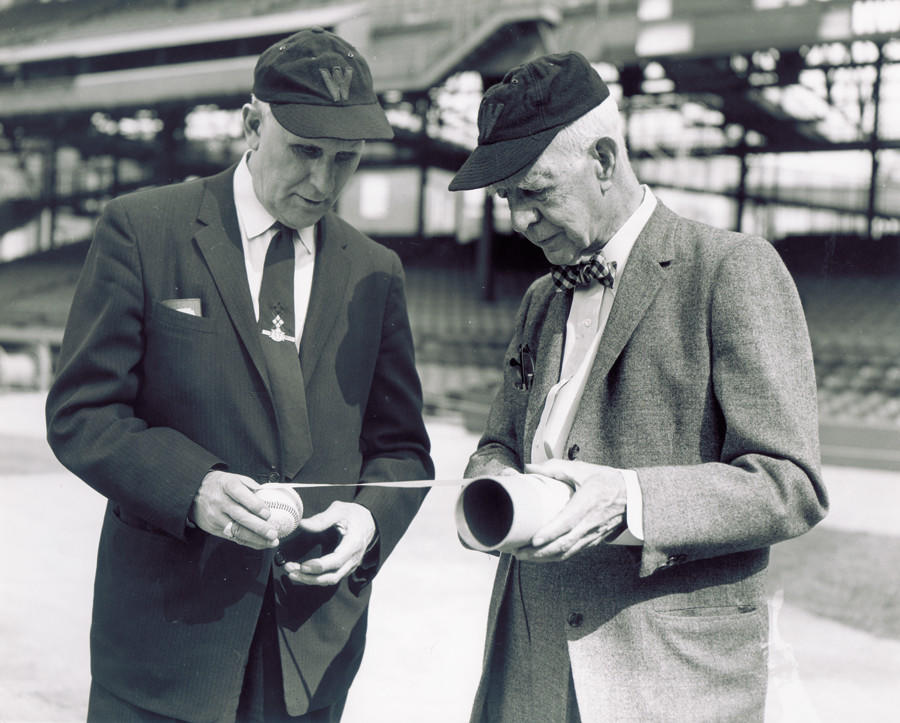By Jeff Stuart
“[The curveball is very difficult to throw, very difficult to control,” said Dick Bosman, former Senators’ pitcher and Tampa Bay Devil Rays’ minor league pitching coordinator. “On an average 12-man staff, you might have two guys who throw curveballs.”
For a long time, physicists argued that a baseball couldn’t curve, that it was an optical illusion. “Shucks, get behind a tree and I’ll hit you with an optical illusion,” the late Dizzy Dean once said. “It ain’t no optical illusion for batters.”
In March, 1959, Washington Senators’ pitchers Pedro Ramos and Camilo Pascual, along with Manager Cookie Lavagetto and catcher Ed FitzGerald helped retired physicist Lyman Briggs, 84, director emeritus of the National Bureau of Standards study the curve ball. Did the ball really curve or was it an optical illusion?
The study was conducted b National Institute of Science and Technology, Griffith Stadium in Washington, and in a wind tunnel at the NBS labs in Gaithersburg, Maryland. (Now the National Institute of Science and Technology) “The spin of a pitched ball was measured with the cooperation of the pitching staff of the Washington Ball Club,” wrote Briggs. “One end of a light flat tape was fastened securely tb the ball. The rest of the long tape, free from twist, was laid loosely on the ground between the rubber and the plate. After the ball had been caught, the number of complete turns in the twisted tape was counted, which ranged from 15 or 16, down to seven or eight turns, while the ball traveled 60 feet. Assuming that the speed of the pitch was 100 feet/sec, the maximum spin was 1,600 rpm.”
Briggs, who lived in Rockville, was a soil scientist, aviation pioneer, physicist, and Manhattan Project (atomic bomb) architect. During World War I he helped develop a device for naval vessels that allowed the firing of the guns to be timed with the roll of the ship. The device was so successful it found its way into the control rooms of most naval vessels.
Briggs was also a lifelong baseball fan. He knew from wind tunnel studies that a spinning ball was really deflected. But how much spin was there on a curveball? Briggs measured that spin. “It will be seen that the speed of the pitched ball has little effect on the amount it curves,” he wrote. “The important thing is the amount of spin. The values are given for a ball spinning about a vertical axis. This is the most favorable position in order to obtain the maximum curve. Usually, the spin axis of a pitched ball is inclined from the vertical, which reduces the curvature. If the spin were horizontal, there would be no sidewise deflection. Assuming the ball to be spinning clockwise, as seen from the right, the resulting pitch would drop.”
The study made headlines: “Physicist has ball for himself,” “Curve now has government approval,” “Dizzy Dean was right,” and “Lavagetto cooks up pitches for science.” The official press release from NBS stated: “The serious purpose of the study is to determine the relationship of spinto deflection at different speeds.” But Briggs, who graduated second in his class at Michigan State and played in the outfield on the Spartans’ baseball team, was now retired and indicated he did it “mostly for the fun of it.”
He published his findings in the “American Journal of Physics.” His paper is still cited today. The ball and ribbon set used in his experiment is preserved at the NIST Museum in Gaithersburg. Briggs’ love for baseball had triggered an earlier piece of research. During World War II, the government had mandated that rubber in baseballs be replaced by cork. Complaints about the new baseballs led Briggs to test them, and in 1945, he demonstrated that the new cork centered baseball were inferior to the old rubber centered baseballs.







